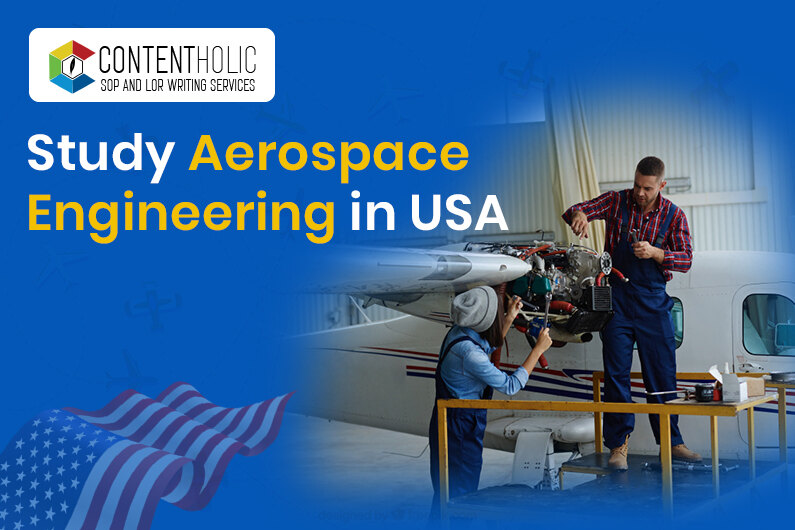The first question which might have come to your mind by looking at the title of this blog post must be why study aerospace engineering in the USA? Before you start Googling about this question, read this blog to get all your answers. This blog will explore not just the answer to these questions but many other aspects as well.
Since this is the first question you thought or we might be the ones who planted this question in your head, let’s extinguish the curiosity about the same. The United States of America has long been a worldwide bigwig in aerospace engineering, possessing some of the world-renowned universities, cutting-edge research facilities, and a vigorously growing industry. An aerospace engineer gets involved in constructing satellites, missiles, and other airborne devices with the help of concepts such as aerodynamics, celestial mechanics, propulsion, etc. If you are an aspiring aerospace engineer, pursuing your training in the USA will present you with unique opportunities to absorb knowledge from industry experts, gain hands-on experience, and eventually embark on a successful career.
History of Aerospace Engineering Industry
If you date back to the early days of aviation, you can trace the innovations that could be associated with the United States. If we ask you who took the first flight or from which country the Apollo mission took place, all the answers would point to the USA as the first flight was taken by the Wright Brothers and the Apollo mission was taken up by NASA–the aeronautical and space administration of the USA.
Of all the technical fields or the engineering branches, aeronautical and aerospace engineering might be the most dynamic and exciting field. The first recorded business transaction in this industry took place between J.P. Morgan and Company and Wright Brothers in New York City in May 1906. In 1909, Glenn Curtis–an American aviation pioneer was the first person to make a commercial sale of an aircraft in the United States. Although, the European manufacturers were ahead in innovation, Americans due to their competitive nature adapted and implemented them much faster. Model 247 of the Boeing Company, first flown in 1933, is considered the first “modern” airliner.
Best Universities and Programs
The USA boasts some of the best universities in the world, offering excellent aerospace engineering programs. These universities have a well-built reputation for academic excellence, innovative research, and expert faculty. We will list down some of the top American universities for you to pursue aerospace engineering:
1. Massachusetts Institute of Technology (MIT):
Celebrated for its meticulous academic standards and the most advanced research, MIT consistently ranks among the top programs for aerospace engineering. The Bachelor’s program focuses on aerospace vehicles and systems. The branches taught in this program would be aerodynamics, fluid mechanics, propulsion, structural design and analysis, advanced materials, and dynamics with additional courses in feedback, control, estimation, control of flight vehicles, software engineering, human systems engineering, aerospace communications, and digital systems.
2. Georgia Institute of Technology:
Georgia Tech offers one of the strong aerospace engineering programs that anchor toward research and innovation. The fee for a Bachelor’s in this course for international students would be USD 32,938. The undergraduate program in the first year would provide courses in other disciplines such as chemistry, mathematics, physics, humanities, and social sciences. The curriculum is designed to make the students industry-ready, for government departments and advanced studies at the Graduate level. The program focuses on the analytical, experimental, and design aspects. The Master’s degree is for 18 months with a fee of USD 23,695. The courses students can choose at the Graduate level are very flexible and more aligned with their professional goals.
3. University of Michigan:
This university has a long history of research and education in the field of aerospace engineering, and aircraft design and propulsion are the nucleus of this program. The tuition fee to pursue a Bachelor in Science and Engineering is USD 60,970. The Master’s fee is USD 58,523. The Master’s program provides more in-depth knowledge about the topics which are already covered at the undergraduate level. This program is specially designed for students who wish to work for the aerospace industry as well as government agencies such as NASA (NASA requires a Master’s degree for employment).
4. Purdue University:
Purdue offers both the theoretical and practical aspects of aeronautical engineering technology in their comprehensive program. To pursue a Bachelor’s degree the fee for international students is USD 28,794. The degree is offered by the university’s College of Engineering. The college also offers a Master’s degree in Aeronautics and Astronautics. The research aspect of this program focuses on aerospace systems, astrodynamics and space applications, autonomy and control, propulsion, structures and materials, dynamics and control, and courses related to the design of flight vehicles. MS in Aeronautics and Astronautics is usually for those who are oriented toward research on challenges faced during the design and operation of aircraft, missiles, and space vehicles and finding their solutions.
5. Stanford University:
Stanford’s aerospace engineering program is an interdisciplinary approach, known for its combination with other disciplines such as computer science and physics. Its BSE in Aeronautics and Astronautics program delivers the students with fundamental principles and methods to be successful in the conception, design, implementation, and operation of aerospace and related engineering systems. During the program duration, students get to do laboratory experiments and understand problems related to aerospace system design. Courses offered in this program are interdisciplinary such as engineering fundamentals, mathematics, and the sciences, as well as in-depth courses in aeronautics and astronautics, dynamics, mechanics of materials, autonomous systems, computational engineering, embedded programming, fluids engineering, and heat transfer. The students after completion of the program can go into the fields of aircraft and spacecraft engineering, autonomy, robotics, unmanned aerial vehicles, drones, space exploration, air and space-based telecommunication industries, computational engineering, teaching, research, military service, and other related technology-intensive fields. The university’s Master’s degree requires no thesis or research work and is composed of basic courses, mathematics courses, technical electives, and other electives.
The admission requirements in all American universities for a Bachelor’s degree in their aerospace programs require a high school diploma with a minimum GPA varying from 2.5 to 3, and English test scores for students from non-speaking countries. Some universities have mandatory requirements for SAT/ACT scores, some don’t.
The eligibility criteria for a Master’s degree at all the universities vary a little, but the most common aspects are a Bachelor’s degree in Aeronautics Engineering with a specialization in Mathematics and Physics. You need to have a minimum of Grade B or a GPA of 3 to 3.5. You have to submit scores on the English proficiency test which should be at least 6.5. Many universities also ask about your GRE scores. You would also need to submit a statement of purpose (SOP), Letters of Recommendation (LOR), CV/resume, financial statements, and work experience (if applicable).
In aerospace engineering, there are many branches you can specialize in such as propulsion and combustible technology, flight mechanics and in-flight control, system design and optimization, safety, security, cyber security and reliability, structural mechanics and material behavior, earth monitoring and space exploration, missile and defense equipment, aeroelasticity and structural dynamics, etc.
Direct Experience and Research Possibilities
One of the most lucrative factors behind pursuing your degree in the USA is that you get hands-on experience and often get the opportunity to be part of innovative research projects. Many universities provide internship and co-op opportunities between the program duration for their students to work in aerospace companies and research laboratories. For any successful career, these kinds of practical experiences are invaluable to gaining the necessary skills and knowledge.
Professional Opportunities
Getting a degree from the USA in aerospace engineering can get you a lot of opportunities. Have you heard of organizations such as Boeing, SpaceX, Gulfstream, Lockheed Martin, and Textron? If yes, then you must know they are all from the US. As a graduate, you can find employment in various sectors such as:
- Aerospace Manufacturing: You can work with firms that design, manufacture, or maintain aircraft and its related equipment.
- Government Agencies: You can work for not just private but government agencies also such as NASA, ISRO, DRDO, the Federal Aviation Administration (FAA), etc.
- Research Institutions: If you are inclined towards research, then you can be part of researching new aerospace technologies, and be a part of this field’s further advancement. As an engineer, you would also be able to evaluate the designs to determine whether the product meets all the expectations. In case of a malfunctioning product, the source of the problem and its solutions are also researched by aerospace engineers.
You can also pursue teaching, especially the Master’s degree holders. According to the U.S. Bureau of Labor Statistics, employment in Aerospace is expected to grow 6% by 2030. You might have heard of Kalpana Chawla, she was an aerospace engineer too! She pursued her Master’s degree from the University of Texas at Arlington, and a second Master’s degree and PhD from the University of Colorado Boulder.
Average Cost it Takes to Become an Aerospace Engineer
Since this program is a very prestigious degree to have, that too from the United States, the cost to pursue this degree can be significant. But don’t start backing off from your dreams because of your financial constraints. There are various financial aids provided by all the universities of the USA to offset your educational expenses. The aids vary from scholarships, loans, grants, and study-work programs. Therefore, it is advisable, that you research all the universities that are offering this program, their fees, and financial aid facilities before applying.
Some of the scholarships available for Graduate students are the William Asbjornsen Albert Memorial Fellowship at MIT, Rotary Peace Fellowships at Purdue, MEC Scholarship and KC Mahindra Trust Scholarship at Cornell, Women in Aerospace Scholarship Foundation Scheme, etc.
Gain Different Cultural Experience
By studying abroad in places such as the USA, you will not only gain a degree from some world-renowned university, and state-of-the-art facilities but also get to experience some unique cultural aspects. You will get to different city or cities, be part of different cultures, and get to be friends with all sorts of people from different backgrounds. US universities are known for their multiculturalism and diversity which can help gain insights into the global aerospace industry.
Conclusion
An aspiring aerospace engineer cannot get a better chance of getting a wealth of opportunities. With the options of the best universities, an ever-growing industry, and a rich cultural experience, the USA is a perfect place to pursue an engineering degree and a career in aerospace. You can expect a successful and exciting career in this field by going to the USA.
Through this blog, we hope that we have answered some of the questions you had about going to the USA to fulfill your passion for aerospace. But there are further steps to get into an American university, such as submitting the right documents, writing essays, letters of recommendation, applying for a study visa, etc. Any small error can stop your progress. This is where study abroad consultants such as Contentholic come to your rescue. Our consultants will help you choose the right university according to your profile and interests, and guide you throughout the admission process. Contenholic’s professional SOP, LOR, and essay writers will also help students prepare honest essays and professional LORs so that the university officials are impressed by your profile.






